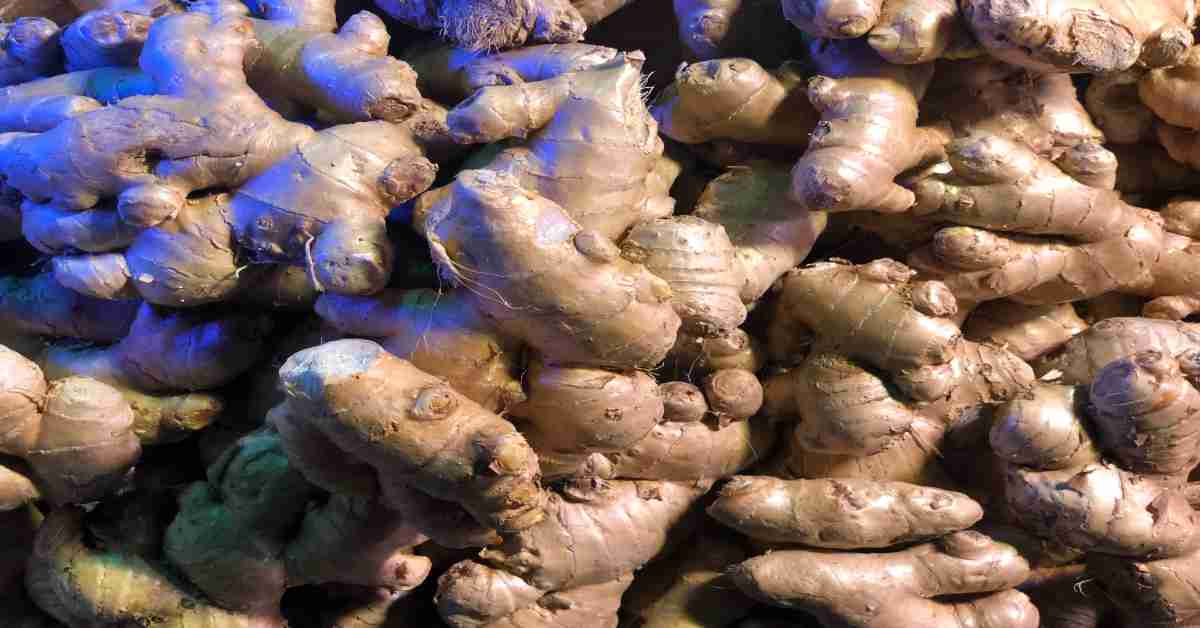The ginger plant is now grown throughout the humid tropics, with India being the greatest producer. Ginger was first produced by Indians and Chinese more than 5000 years as a tonic root to heal a variety of diseases. A family of plants that also comprises cardamom and turmeric includes ginger. There are many benefits of Ginger like pain, nausea, vomiting, and many more!
About Ginger
Ginger (Zingiber officinale Roscoe) is a popular medicinal plant that is widely used for ages as a flavoring ingredient and herbal medicine. The word “ginger” as we know it today derives from the Middle English word “gingivere,” although the Sanskrit word “srngaveram,” which means “horn root,” refers to this spice and is nearly 3000 years older. Ginger is known as zingiber in Latin and zingibers in Greek. It is interesting to note that ginger does not grow naturally in the wild, and its true ancestry is unknown.
Additionally, benefits of ginger rhizome eating is a widespread traditional cure for common health problems such as pain, nausea, and vomiting. Importantly, numerous randomized controlled trials were undertaken to investigate ginger’s antiemetic impact in a variety of circumstances such as motion sickness, pregnancy, and post-anesthesia.
Ginger is harvested at nine months or later if oil extraction is the primary goal. Ginger is frequently preserved in sweet vinegar, which gives it a pink hue; sushi lovers love this kind of ginger. In biscuits, cakes, and curry mixes, this is the form that is most frequently utilized in our spice racks. Ginger boiled in sugar syrup and dusted with granulated sugar. The rhizomes of ginger harvested at 5 months are tender with a mild flavor and are best utilized fresh or preserved. It also has very thin skin and is not yet fully developed.
History that shows the benefits of Ginger
Long before history was properly documented, ginger was utilized as a flavoring agent. Almost 2000 years ago, it was highly esteemed for its therapeutic properties and exported from India to the Roman Empire as a very valuable piece of the trade. Ginger was still a high commodity in Europe even after the Roman Empire fell. Arab traders predominated the trade in ginger and other spices for ages. The price of a pound of ginger in the thirteenth and fourteenth centuries.
Gingerols, in particular, appear to be the key component of ginger studied in much health-related scientific research and are the primary reason for its strong aroma. The rhizome is consumed as the primary part of ginger, which is the horizontal stem from which the roots grow.
Ginger is one of the world’s most popular dietary condiments. According to reports, ginger contains more than 100 different chemicals. In particular, gingerol, shogaols, zingiberene, and zingerone are the main groups of compounds found in ginger, along with a few other less prevalent ones like terpenes, vitamins, and minerals. Gingerols are among the major components, with many pharmacological and physiological effects.
The number of studies on the health advantages of ginger has significantly increased as a result of these possible pharmacological and physiological activities. In terms of therapeutic features, there has been a trend of mounting proof of ginger’s positive impact on human health. Ginger has been treating many conditions, including colds, nausea, arthritis, migraines, and hypertension for thousands of years. Several biological activities, such as antioxidants, antibacterial, and anti-neuroinflammation, to name a few, are already investigated.
Furthermore, in recent years, ginger’s involvement in anticancer, chemotherapy-induced nausea and vomiting (CINV), weariness, as well as improvements in the quality of life in daily human labor.
How to Increase Your Consumption of Ginger
There are numerous methods to begin incorporating ginger into your diet if you’re wondering how to eat it for health benefits. Choose a technique you like, then include it in your diet.
1. Ginger Tea
Ginger tea is one of the most popular methods to consume ginger. To make ginger tea, steep pieces of chopped or sliced ginger in water.
2. Ginger juice
One of the most common methods to consume ginger is a daily injection of ginger juice. These are simple to prepare at home with a juicer. Spice Up Your Foods
3. Add Spice to Your Meals
Add minced ginger to meals to gain benefits and add taste. Ginger is delicious in stir-fries, soups, and curries. You can also put ginger in desserts or smoothies.
Health benefits of Ginger
There are numerous health benefits of ginger which includes-
Part 1
- Enhances Immunity
Gingerol, a bioactive chemical found in raw ginger, improves immunity due to its antibacterial and antifungal properties. The combination of these qualities has numerous advantages. These ginger health advantages and side effects improve coughs, lower fevers, fight infections, relieve headaches, and alleviate other symptoms of common colds and the flu. - Reduces Nausea and Stomach Pain
One of ginger’s most well-known health advantages is its ability to alleviate nausea. Ginger relieves stomach discomfort caused by motion sickness, migraines, morning sickness, or other gastrointestinal problems.
It achieves this through having anti-inflammatory properties that quiet the body down, improving digestive responsiveness, and producing hormones that regulate blood pressure. - Anti-inflammatory effects
Ginger poses several health benefits, including the capacity to reduce inflammation, edema, and pain. A dried ginger extract and a dry gingerol-enriched extract both have analgesic and anti-inflammatory properties. - Antioxidant activity
Many disorders occur due to oxidative stress, and ginger’s antioxidant qualities are frequently act as a common mechanism to explain its activities and health advantages. According to several studies, ginger lowers oxidative stress markers to aging. Only pomegranate and several kinds of berries have a higher total antioxidant content than ginger root. - Anticancer activity
Researchers disagree on the exact mechanism through which ginger works as a spice to prevent cancer. Several components of ginger, including [6]-gingerol, [6]-shogaol, [6]-paradol, and zerumbone, have antitumorigenic properties. Prostate, skin, breast, ovarian, gastric, gastrointestinal, ovarian, hepatic, and colorectal cancers can all be effectively control with ginger and its bioactive components.
Part 2
- Anti-diabetic properties
Ginger is also effective against diabetes. Ginger dramatically reduced blood glucose, total cholesterol, LDL, VLDL, and triglycerides while increasing HDL. - Enhanced Digestion
Ginger helps to speed up digestion and promotes faster stomach emptying. Including it in their normal diet may provide comfort for someone suffering from digestive problems such as indigestion, ulcers, constipation, and IBS.
According to studies, people who ingest ginger digest food twice as quickly. It encourages beneficial enzymes to help break down the food we eat and enhances motility in the digestive tract. - Cardiovascular Disease Prevention
Ginger, in addition to its other characteristics, acts as a blood thinner, which is good for reducing cardiovascular problems. Blood thinners lower the chance of blood clots, lowering your risk of heart attack or stroke.
Ginger lowers cholesterol and blood pressure, which helps to prevent heart disease. Cholesterol buildup can obstruct arteries and increase the risk of heart disease. Ginger also increases circulation and decreases blood sugar, which helps the heart to work properly. - Weight loss
Consuming ginger can help with weight loss, according to certain research. Ginger regulates insulin levels, increases metabolism, and facilitates post-workout recovery. By revving up your metabolism and producing a feeling of fullness to curb overeating, ginger aids in weight loss. - Reduces menstrual symptoms
Menstrual discomfort is a frequent sensation throughout a woman’s period, but consuming ginger may make it more manageable. Taking ginger during the first three days of your menstrual cycle relieves discomfort and relieves the bloat associated with premenstrual symptoms.




